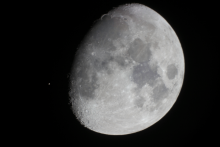Listen to today's episode of StarDate on the web the same day it airs in high-quality streaming audio without any extra ads or announcements. Choose a $8 one-month pass, or listen every day for a year for just $30.
You are here
Moon and Aldebaran
The Moon and the bright star Aldebaran continue a game of “peek-a-boo” this evening that they’ve been playing for more than two years. The Moon will pass directly in front of the star, blocking it from view. The entire event will be visible across most of the United States.
This is just one of a series of such disappearing acts, known as occultations, that began in January of 2015. The Moon has passed in front of the star every month since then, although not all of the events have been visible from the U.S.
Over the decades, occultations have helped astronomers learn a lot about quite a few stars, including Aldebaran. The amount of time it takes the star to disappear behind the Moon, for example, helps reveal how big the star is. In the case of Aldebaran, occultations and other techniques show that it’s more than 40 times the diameter of the Sun — a true giant among stars.
Occultations can also reveal companion stars. In those cases, a system’s brightness exhibits a two-step drop as the star disappears behind the Moon, and a two-step rise as it returns to view — one “step” for each star. Aldebaran shows no such profile, indicating that it travels alone.
Look for Aldebaran close above the Moon as darkness falls. It passes behind the nighttime portion of the Moon, then emerges below the illuminated portion of the Moon a bit later. The exact timing depends on your location, as the Moon and Aldebaran once again play peek-a-boo.
Script by Damond Benningfield



